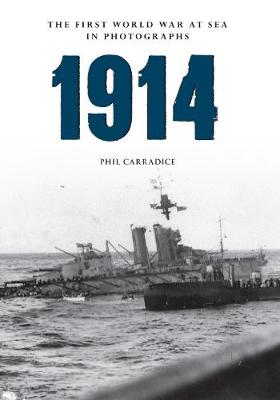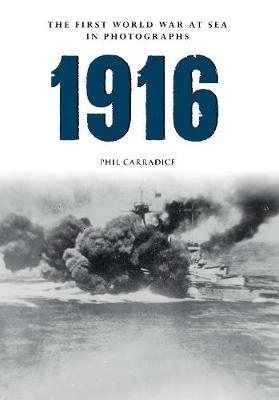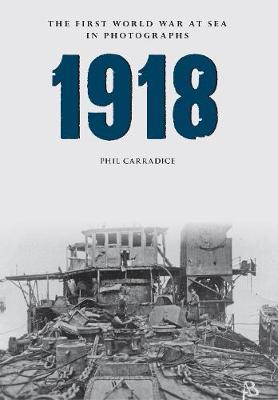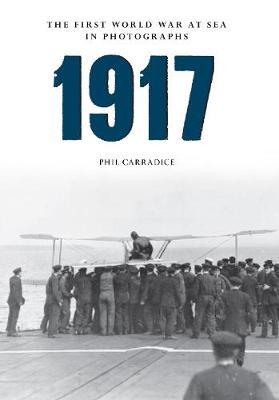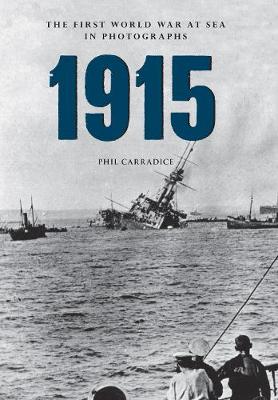The First World War at Sea in Photographs
5 total works
The arms race that led to the First World War started in 1897 at the Spithead Naval Review, when Kaiser Wilhelm saw the might of Britain's Navy. He wanted to equal or better the fleet of Britain, and set about a huge building programme of warships. By 1914, tensions in Europe were at a breaking point and, in August, erupted into what would become the first truly global conflict. From almost the first day of the war, as merchant ships scuttled to safe havens, the war at sea saw ship against ship and submarine against ship. Hastily converted merchantmen became auxiliary cruisers, fitted with guns and ready for action. August saw the loss of the Kaiser Wilhelm der Grosse, one of Germany's crack ocean liners, off the coast of Africa; October, the loss of Britain's dreadnought battleship HMS Audacious to a mine; and December saw the Battle of the Falklands and a German attack on the coastal towns of Scarborough, Whitby and Hartlepool. Submarines quickly became a menace in the Mediterranean, English Channel and North Sea, slowly beginning to starve Britain into submission.
In August, it was thought the war would be over by Christmas; by December everyone knew they were in for a long, hard slog. The naval war would be one of attrition and one that would ultimately lead to the surrender of Germany's navy in 1918.
In August, it was thought the war would be over by Christmas; by December everyone knew they were in for a long, hard slog. The naval war would be one of attrition and one that would ultimately lead to the surrender of Germany's navy in 1918.
For the navies of Britain and Germany, 1916 would be the defining year of the First World War. Against a background of the evacuation of the Dardanelles, blockades in the North Sea and submarine attacks around the coasts of Europe, the British Grand Fleet and the German High Seas Fleet would meet in the North Sea on 31 May 1916 and slug it out for supremacy. Which would win, Britain or Germany? With both sides claiming victory, Jutland ended as a draw. Nonetheless, neither fleet would venture out in force again for the duration. Future naval engagements would be skirmishes rather than all-out sea battles.
Outrages against hospital ships and continued submarine warfare against merchant vessels saw numerous high profile sinkings, not least the hospital ship HMHS Britannic, lost in November in the Kea Channel, sunk by an indiscriminate mine.
Phil Carradice takes us through the First World War at sea in photographs, showing us the horror of war and telling the story of the greatest sea battle of the conflict.
Outrages against hospital ships and continued submarine warfare against merchant vessels saw numerous high profile sinkings, not least the hospital ship HMHS Britannic, lost in November in the Kea Channel, sunk by an indiscriminate mine.
Phil Carradice takes us through the First World War at sea in photographs, showing us the horror of war and telling the story of the greatest sea battle of the conflict.
The year 1918 was dominated by the Armistice and the end of the fighting in the War to End All Wars. However, before that both the U-boat war in the North Atlantic and the British blockade of Germany continued unabated. The Royal Navy attempted to block the German naval forces in the Belgian port of Zeebrugge into the harbour with a raid on St George's Day and the Royal Naval Air Service was amalgamated into the Royal Flying Corps to form the RAF on 1 April. The Royal Navy was also involved in the British intervention against the Bolsheviks in the Russian Civil War.
After the Armistice came, the Royal Navy's work was not finished. The German surface fleet was interned in Scapa Flow from 23 November, only for the ships' crews to scuttle their vessels on 21 June 1919. The U-boat fleet also surrendered. Finally, in November 1920, there was the solemn task of transporting the body of the Unknown Warrior across the Channel from Boulogne to Dover for burial in Westminster Abbey.
Phil Carradice takes us through the First World War at sea in photographs, showing us the horror of war and telling the story of some of the key moments of the conflict.
After the Armistice came, the Royal Navy's work was not finished. The German surface fleet was interned in Scapa Flow from 23 November, only for the ships' crews to scuttle their vessels on 21 June 1919. The U-boat fleet also surrendered. Finally, in November 1920, there was the solemn task of transporting the body of the Unknown Warrior across the Channel from Boulogne to Dover for burial in Westminster Abbey.
Phil Carradice takes us through the First World War at sea in photographs, showing us the horror of war and telling the story of some of the key moments of the conflict.
The year 1917 was dominated by the Russian Revolution and America entering the war. On 3 February, America cut diplomatic ties with Germany following the announcement on 31 January that Germany would begin unrestricted submarine warfare. All 111 U-boats were ordered to sink any vessel at will. The hope was that Britain would be starved into submission. America declared war on 6 April and US destroyers joined the fight against the U-boats while US battleships joined the Grand Fleet at Scapa Flow. Losses to submarines were now so great that Britain was in danger of running out of food and the convoy system was brought into force. The impact was huge and German U-boat losses climbed rapidly.
At Scapa Flow, on the evening of 9 July 1917, the battleship HMS Vanguard exploded. On 2 August 1917, Squadron Commander Edwin Dunning successfully landed a Sopwith Pup on board HMS Furious, becoming the first person to land an aircraft on a moving ship. The aircraft carrier had come of age. Meanwhile, in Petrograd the start of the Bolshevik Revolution was signaled when the cruiser Aurora fi red at the Winter Palace.
Phil Carradice takes us through the First World War at sea in photographs, showing us the horror of war and telling the story of some of the key moments of the conflict.
At Scapa Flow, on the evening of 9 July 1917, the battleship HMS Vanguard exploded. On 2 August 1917, Squadron Commander Edwin Dunning successfully landed a Sopwith Pup on board HMS Furious, becoming the first person to land an aircraft on a moving ship. The aircraft carrier had come of age. Meanwhile, in Petrograd the start of the Bolshevik Revolution was signaled when the cruiser Aurora fi red at the Winter Palace.
Phil Carradice takes us through the First World War at sea in photographs, showing us the horror of war and telling the story of some of the key moments of the conflict.
Submarines and blockades dominated the war at sea in 1915. The major event was the sinking by U-20 of the Lusitania, which edged America closer to war. The Germans had announced a blockade of Britain in February, using submarines to sink and harry shipping. A British blockade of Germany was announced in March in retaliation. Using its surface fleet to stop neutral vessels, the British attempt was more successful. The British submarine force was also successful, commanders leading patrols into the Black Sea and the Baltic Sea.
Surface ship engagements would be fought by battlecruisers at the Battle of the Dogger Bank, and by cruisers off the coast of Chile as the German warship Dresden was sunk in the Pacific. On the east coast of Africa, the raider Koenigsberg was sunk in the war's first instance of sea-air cooperation.
Attempts to bully Turkey into surrendering saw numerous Allied warships sunk off the Dardanelles and an amphibious landing took place there in an attempt to create a supply route into the Black Sea. By the end of the year it was obvious that the invasion of Turkey had failed and the soldiers were evacuated. At the same time, Allied shipping was being used to evacuate the Serbian army from the coast of Albania, the biggest seaborne evacuation that there had ever been until Dunkirk.
Surface ship engagements would be fought by battlecruisers at the Battle of the Dogger Bank, and by cruisers off the coast of Chile as the German warship Dresden was sunk in the Pacific. On the east coast of Africa, the raider Koenigsberg was sunk in the war's first instance of sea-air cooperation.
Attempts to bully Turkey into surrendering saw numerous Allied warships sunk off the Dardanelles and an amphibious landing took place there in an attempt to create a supply route into the Black Sea. By the end of the year it was obvious that the invasion of Turkey had failed and the soldiers were evacuated. At the same time, Allied shipping was being used to evacuate the Serbian army from the coast of Albania, the biggest seaborne evacuation that there had ever been until Dunkirk.
